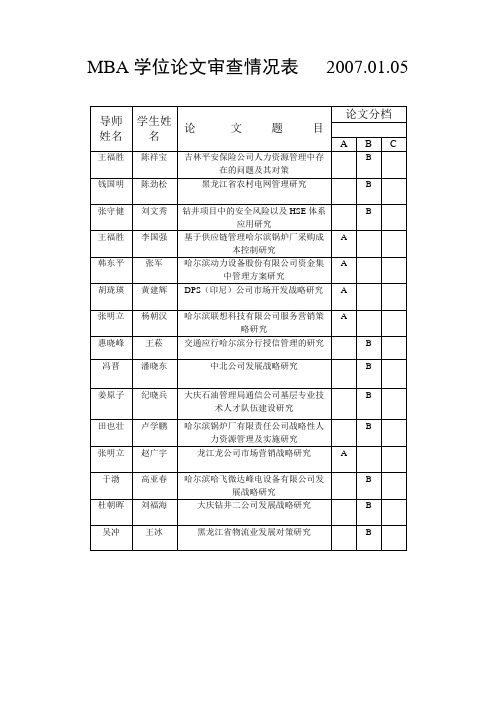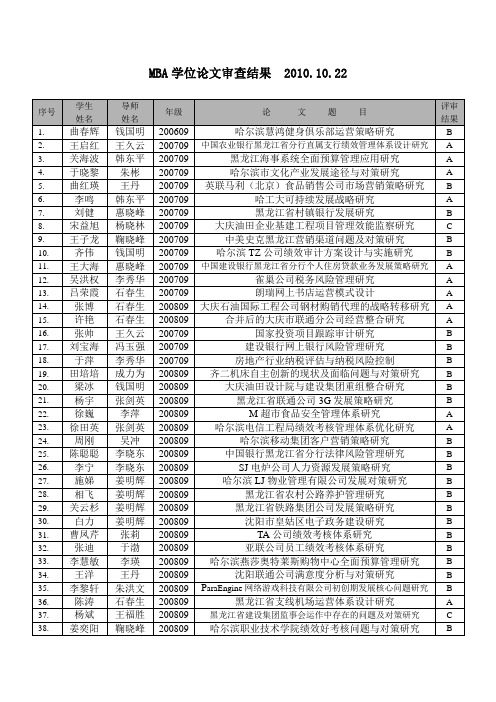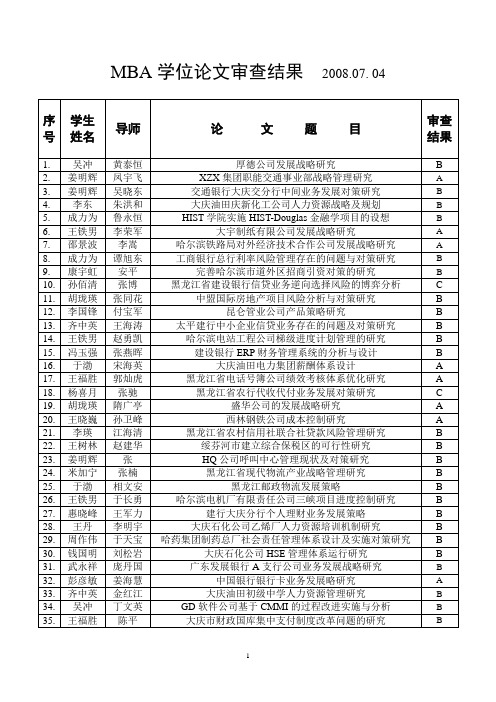MBA学位论文审查情况表-哈尔滨工业大学管理学院
- 格式:doc
- 大小:106.50 KB
- 文档页数:2

学位管理情况汇报表模板学位管理情况汇报表。
尊敬的领导:我根据学位管理情况,特向您汇报如下:一、学位授予情况。
1. 本科生学位授予情况,截至目前,我校共有XXX名本科生顺利完成学业,其中有XX名获得学士学位。
2. 研究生学位授予情况,截至目前,我校共有XXX名研究生完成学业,其中有XX名获得硕士学位,XX名获得博士学位。
二、学位授予质量情况。
1. 学位授予质量稳步提升,近年来,学校高度重视学位授予质量,加强学位论文质量把控,严格学术规范,确保学位授予质量。
2. 学位论文质量评估,学校建立了严格的学位论文评审制度,对学位论文进行严格评审,确保学位论文的学术水平和质量。
三、学位管理改革情况。
1. 学位管理制度不断完善,学校不断完善学位管理制度,加强学位管理规范化建设,提高学位管理效率。
2. 学位管理信息化建设,学校积极推进学位管理信息化建设,建立了完善的学位管理信息系统,提高了学位管理工作效率和质量。
四、学位管理工作亮点。
1. 学位管理工作取得显著成效,学校学位管理工作取得了显著成效,学位授予质量稳步提升,学位管理制度不断完善,学位管理工作取得了显著成效。
2. 学位管理工作获得社会认可,学校学位管理工作获得了社会各界的认可和好评,为学校的发展和建设做出了积极贡献。
五、学位管理存在问题及改进措施。
1. 学位管理存在问题,学位管理工作中还存在一些问题,如学位授予质量仍有提升空间,学位管理制度还需进一步完善。
2. 改进措施,学校将进一步加强学位管理工作,完善学位管理制度,提高学位授予质量,确保学位管理工作的顺利进行。
以上就是我校学位管理情况的汇报,希望领导能够给予指导和支持,共同推动学位管理工作取得更大的成绩。
特此汇报。
学校学位管理办公室。
日期,XXXX年XX月XX日。



165次MBA/工程硕士论文评审结果编号类别学号学生姓名导师姓名论文题目评审结果M1MBA13QM10001白鹤钱国明龙广网络公司重点物资库存管理策略研究BM2MBA13QM10015崔常松陶萍“营改增”对建行黑龙江省分行税负变化的影响及对策研究BM3MBA13QM10020段显扬胡龙英JD公司发展战略研究BM4MBA13QM10025郭微石春生H公司驻车加热器产品营销战略组合分析BM5MBA13QM10035康春岩王丹哈飞工业机电设备制造公司服务化转型战略研究BM6MBA13QM10104肖阳李国鑫XYTY药房DTC模式推广与营销策略BM7MBA14QM10003陈福龙胡龙英中国商飞供应商制造过程质量管理研究-以供应商哈飞为例BM8MBA14QM10016范旭光陶萍黑龙江省股份制商业银行同业业务风险控制模式研究(二审)通过M9MBA14QM10021郭胜男彭彦敏并购蒙牛对中粮的贡献研究BM10MBA14QM10024韩蕊程巧莲COACH公司在东北区域市场的发展策略研究(二审)通过M11MBA14QM10030姜琳程延江LH集团港口物流业务发展策略研究BM12MBA14QM10040李雪娇陶萍H公司绩效管理研究BM13MBA14QM10042李毅涛祁巍哈尔滨市城区邮政投递运营策略优化研究(二审)通过M14MBA14QM10043李映欣程延江龙江电力设计院质量管理体系改进研究CM15MBA14QM10050刘宏恩杨洋HB公司全面质量管理体系优化研究BM16MBA14QM10051刘建敏胡龙英巴基斯坦BHIKKI电站EPC项目风险管理研究AM17MBA14QM10055刘思王铁男蓝色光标投资并购绩效的研究(三审)通过M18MBA14QM10082汪哲程巧莲平安银行高级管理人员薪酬激励分析BM19MBA14QM10083王成丽梁大鹏基于AHP-模糊方法的网络订餐行业客户信任度提升问题研究(三审)通过M20MBA14QM10093王智渊彭彦敏滴滴并购快的案例研究BM21MBA14QM10103薛丽娜翟凤勇L煤矿公司安全生产应急预案管理优化研究(二审)通过M22MBA14QM10116于子洋郭景远哈尔滨银行哈尔滨分行中小企业信贷业务发展研究(三审)通过M23MBA14QM10118张慧媛康宇虹满洲里农商行小微企业信贷风险管控对策研究B M24MBA14QM10124张奇涵康宇虹H省烟草公司卷烟营销策略优化研究B M25MBA14QM10127张笑宁邵景波杜尔伯特润生村镇银行发展中存在的问题及对策研究C M26MBA14QM10135赵永生冯晋新常态下中国邮政集团公司黑龙江省分公司人才发展战略研究B M27MBA14QM10137周姮吴冲工行哈尔滨房信支行住房开发贷款业务管理提升对策研究C M28MBA15SM10207安良玉田也壮黑龙江省九〇四水勘院绩效考核研究B M29MBA15SM10211陈曦桐郭熙铜A事业单位转企对知识型员工激励方案的研究B M30MBA15SM10218杜梦迪惠晓峰A银行呼叫中心新座席KPI改进研究B M31MBA15SM10228国梦莹李萍G银行H分行柜面员工管理流失问题研究B M32MBA15SM10231韩旭鹏王福胜黑龙江BF农业集团融资问题与对策研究B M33MBA15SM10233韩之光赵泽斌交通银行黑龙江省分行信用卡网络发卡发展策略研究B M34MBA15SM10234何璐王铁男龙煤集团市场竞争战略分析与选择B M35MBA15SM10235赫雪迪田也壮L公司ERP实施团队绩效改善方案研究B M36MBA15SM10237黄世成姜原子松花江干流堤防工程多标段施工的绩效评价研究B M38MBA15SM10243姜晓爱刘鲁宁H公司基建工程自动竣工决算模式研究与成效分析B M39MBA15SM10270马昊驰高艳茹H投资基金管理公司的运营风险评估构建研究B M40MBA15SM10272苗生杰程巧莲A排气系统有限公司物流成本控制研究B M41MBA15SM10277秦瑛赵泽斌中国农业银行H分行法人客户信贷业务真实性核查研究B M42MBA15SM10279商佳宁邵景波XL购物中心市场营销策略研究B M43MBA15SM10283宋志一程巧莲M供电公司绩效评价体系优化研究BM44MBA15SM10284孙婷婷陶萍DQ移动公司成本控制研究B M45MBA15SM10285孙婷婷高艳茹F仿真技术研究所成本管理体系研究B M46MBA15SM10290唐潮邵景波黑龙江省铁路集团公司绩效考核问题研究B M47MBA15SM10291唐海婷叶强S公司绩效考核方案研究B M49MBA15SM10297王春晓翟凤勇大数据背景下铁路企业网络舆情的管理与应对C M50MBA15SM10299王慧光周燕阿城区龙涤中学物理学科教育信息化问题分析及对策研究B M51MBA15SM10300王慧颖史剑新哈尔滨银行存款负债业务改进对策研究B M52MBA15SM10303王乐彭彦敏哈行贷款风险控制研究C M53MBA15SM10306王梦夏彭彦敏中行黑分行人力资源管理改进措施研究C M54MBA15SM10310王天天张紫琼广州GW酒店精准营销策略研究(三审)通过M55MBA15SM10325辛远吴伟伟中国移动黑龙江省公司集团专线业务战略研究B M56MBA15SM10326邢颖李国峰H银行零售客户营销问题分析及对策研究B M57MBA15SM10327徐骁段云哈尔滨市南岗区建筑业营改增问题分析及对策研究B M58MBA15SM10331杨晶赵泽斌中国农业银行伊春分行绿色信贷产品创新研究B M59MBA15SM10332杨钧壬马涛黑龙江BTV传媒市场化运营研究B M60MBA15SM10333杨兴家康宇虹A汽车销售公司纳税筹划方案设计B M61MBA15SM10334杨湛超叶强易帮智慧社区服务平台商业模式研究(三审)通过M62MBA15SM10338于静雅张紫琼大庆油田海外市场开发策略研究C M63MBA15SM10341张爱红李东黑龙江A军工制造企业质量管理信息化建设研究C M64MBA15SM10343张代影郭海凤CZ银行投资银行业务发展策略研究B M65MBA15SM10345张明悦钱国明基于CMMI的工大软件公司软件产品开发过程管理改造研究B M66MBA15SM10359周海青姜原子D公司库存管理改进的研究B编号类别学号学生姓名导师姓名论文题目评审结果G1工程硕士12SG10007耿凯孙成双百联超市照明系统节能改造项目的合同能源管理BG2工程硕士12SG10008项明鉴陈健黑龙江广播电视台节目制作的项目化管理研究BG3工程硕士12SG10015李野孙成双哈尔滨新龙水利有限公司项目成本管理体系研究BG4工程硕士12SG10019徐美娜邹波企业大型技术改造工程项目成本控制优化研究—以哈尔滨发电有限公司为例CG5工程硕士12SG10020张乘瑞许程洁定量分析模型在巴拿马300MW水轮发电机项目中的应用BG6工程硕士12SG10022刘澍许程洁内河项目合同管理研究CG7工程硕士12SG10029邹禹于渤五常市污水处理项目风险管理研究CG8工程硕士12SG10030温奇山许程洁牡丹江青梅大桥施工进度控制研究BG9工程硕士12SG10038马晓宇李良宝航天某中心项目群管理应用方案研究BG10工程硕士12SG10041杨旭祁巍ERP系统的航天XX研究所科研多项目管理中的应用研究CG11工程硕士12SG10042葛铠姜维航天电源产品的外协质量监控方法研究CG12工程硕士12SG10043班齐马维忠控制系统集成交付平台现场管理质量综合评价BG13工程硕士12SG10044吴骅姜原子A型号特种车研制项目质量管理方案研究BG14工程硕士12SG10046张朋郝生宾北京航天发射技术研究所“军转民”项目成本管理研究BG15工程硕士12SG10050王锦峰杨晓林QFD方法在新型飞行器结构研制项目中的应用研究BG16工程硕士12SG10058潘亮吴隽某运载火箭发动机精品塑造项目质量管理研究BG17工程硕士12SG10059徐光柳邹波A公司公有云平台敏捷项目管理策略研究BG18工程硕士13SG10016张金华卢乃吉佳木斯邮政农村电商发展策略研究CG19工程硕士14SG10027杨威于渤H高校继续教育培训项目团队激励机制的研究B。

Paper Format for the Proceedings of the International Conference on Management Science and Engineering 2008LAN Hua1,ZHAO Shu-rong 21 School of Management, Harbin Institute of Technology, P.R.China, 1500012 School of Humanities and Science of UESTC, P.R.China, 610054Abstract: These instructions give you basicguidelines for preparing papers for the ICMSE 2008Proceedings. Submitted papers should be at least 6 pages.Papers must be submitted using this format. Thisdocument is a template for Microsoft Word. If you arereading a paper version of this document, pleasedownload the electronic file from the Conference website() so you can use it to prepare yourmanuscript. Abstract should be more than 120 EnglishWords. There should be at least 4 keywords and shouldin alphabetical order of the first letter of the beginningword, separated by commas.Keywords: Font, Format, Margins1 IntroductionPlease prepare your paper using a A4 page size of210mm 297mm. Set the row spacing in paragraphmenu as single row spacing. Indent paragraphs by 4characters. There should be one blank line above andbelow each section title, while only one blank line abovethe subheading. All figures, tables, and equations must beincluded in-line with the text. Do not use links toexternal files.2 Methodology2.1 FormatIn formatting your page, set top margin to 25mmand bottom margin to 31mm. Left and right marginsshould be 20mm. Page header should be 13mm and pagefooter should be 20mm. In document gridding menu,choose no gridding. Use a two-column format whereeach column is 21.95 characters wide and spacing 2characters.Tab.1 Type size and typeface for papersType Size (pts)AppearanceTimes New Roman Times New Roman Bold9 Figures, tables Figure captions, table names10 Main text, equations,referencesSubheadings12 Authors’ names Section titles14 Paper title 2.2 Type sizes and typefacesTry to follow the type sizes and typefaces specified in Tab. 1 as best as your can. The whole paper should use Times New Roman font. Use 14 point bold characters for the paper title, and capitalize the first letter of each substantive in the title. Author names should use 12 point characters and separated by commas. Capitalize the surnames and the first letters of the first names. Use a hyphen between first names. Use superscript on the right if authors’ sequence numbers are necessary. Use 10 point characters for the main text and author’s affiliations, please be sure that there are sequence numbers in front of them and add ―P.R.China, zip code‖at the end. Capitalize the first letter of the beginning word for each section title and subheading. Use 12 point bold Roman characters for section titles and 10 point bold Roman characters for subheadings.3 Results3.1 Figures and tablesPosition figures and tables should be at the tops and bottoms of columns. Avoid placing them in the middle of columns. Large figures and tables may span across both columns.Use 9 point characters for figures and tables, bold characters for figure captions and table names. Capitalize the first letter of the beginning word of each figure caption and table name.Leave one blank line between the table name and above main text. Place the table name above the table, using the abbreviation ―Tab‖, such as ―Tab.1‖. Use the abbreviation ―Tab.1‖ if you want to refer the table in thetext.Fig.1 Magnetization as a function of applied fieldTry to use the drawing tool provided by Microsoft Word. For those which cannot be done by Word, please do not include the figure name. The figure name should be typed in Word alone. In order to be sure of the legibleness of the paper, please do not use color and gray scale image to express different meanings, as we adapt concolorous printing.Figure caption should be below the figures. Use the abbreviation ―Fig‖, even at the beginning of a sentence, such as ―Fig.1‖. Leave one blank line between figure caption and the text below.3.2 ReferencesThere should be no less than 20 references. Number citations consecutively in square brackets. And number them in superscripts. The sentence punctuation follows the bracket. References at the end of the paper should be follow the order of the citations appeared in the paper.Please note that the references at the end of this document are in the preferred referencing style.Give all authors’ names; do not use ―et al.‖ unless there are six authors or more. Use a space after authors' initials. Capitalize only the first word in a paper title, except for proper nouns and element symbols. For papers published in translation journals, please give the English citation first, followed by the classification of the original foreign-language in parentheses.3.3 Abbreviation and acronymsDefine abbreviations and acronyms the first time they are used in the text, even after they have already been defined in the abstract. Abbreviations such as IEEE, SI, MKS, CGS, ac, dc, and rms do not have to be defined. Abbreviations that incorporate periods should not have spaces: write ―C.N.R.S.,‖ not ―C. N. R. S.‖ Do not use abbreviations in the title unless they are unavoidable.3.4 EquationsPlease use equation tools provided by Microsoft Word to edit your equations. Number equations consecutively with equation numbers in parentheses flush with the right margin, as in (1).A +B = C(1)Be sure that the symbols in your equation have been defined before the equation appears or immediately following. Italicize variables.3.5 Other recommendationsNumber the section titles using Roman numerals. The type size and typeface of Introduction and References are the same as section titles. Number Introduction, but not References. References should be placed in the middle of column. The section titles and subheadings should be at the margin. Type a space after a period or a colon.Use a zero before decimal points: ―0.25,‖ not ―.25.‖ Use ―cm3,‖ not ―cc.‖ Indicate sample dimensions as ―0.1 cm ⨯0.2 cm,‖ not ―0.1 ⨯ 0.2 cm2.‖4 ConclusionFinally, you are responsible for language as experts or editors will not check it. Do a spell and grammar check. This is available in Word. If English is not your native language, get a professional proof-reader to help if possible.Prefixes such as ―non,‖―sub,‖ ―micro,‖ ―multi,‖ and ―ultra‖ are not independent words; they should be joined to the words they modify, usually without a hyphen.Sponsor and financial support acknowledgments are placed in the unnumbered footnote on the first page.References[1] D. J. Beebe, Signal conversion (book style with paper title and editor) in biomedical digital signal processing, W. J. Tompkins, Ed. Englewood Cliffs, NJ: Prentice-Hall, 1993, ch. 3, pp. 61–74.[2] M. Akay, time frequency and wavelets in biomedical signal processing (book style). piscataway, NJ: IEEE press, 1998, pp. 123–135.[3] G. B. Gentili, V. Tesi, M. Linari, and M. Marsili, A versatile microwave plethysmograph for the monitoring of physiological parameters (Periodical style), IEEE trans. biomed. eng., vol. 49, no. 10, pp. 1204–1210, Oct. 2002.[4] V. Medina, R. Valdes, J. Azpiroz, and E. Sacristan, title of paper if known, unpublished.[5] E. H. Miller, A note on reflector arrays (periodical style—accepted for publication), IEEE trans. antennas propagat., in press.[6] T. Menendez, S. Achenbach, W. Moshage, M. Flug, E. Beinder, A. Kollert, A. Bittel, and K. Bachmann, Prenatal recording of fetal heart action with magnetocardiography (in German), Zeitschrift für Kardiologie, vol. 87, no. 2, pp. 111–8, 1998.[7] J. E. Monzon, The cultural approach to telemedicine in Latin American homes (published conference proceedings style), in proc. 3rd conf. information technology applications in biomedicine, ITAB´00, arlington, VA, pp. 50–53.[8] F. A. Saunders, Electrotactile sensory aids for the handicapped (presented conference paper style), presented at the 4th annu. meeting biomedical engineering society, Los Angeles, CA, 1973.[9] J. R. Boheki, Adaptive AR model spectral parameters for monitoring neonatal EEG (Thesis or dissertation style), Ph.D. dissertation, Biomed. Eng. program, Univ. Fed. Rio de Janeiro, Rio de Janeiro, Brazil, 2000. [10] J. P. Wilkinson, Nonlinear resonant circuit devices (Patent style), U.S. Patent 3 624 12, July 16, 1990. [11] R. E. Haskell and C. T. Case, Transient signal propagation in lossless isotropic plasmas (report style), USAF cambridge Res. Lab., cambridge, MA Rep. ARCRL-66-234 (II), 1994, vol. 2.。

MBA报考指南:哪些MBA学校有国际认证?许多同学大约是离开校园已久,忽然决定要考MBA,总感觉无从下手。
加油站的老师们常常被问及有关于MBA的一些常识和院校问题。
我们很能理解各位大大,在这里将就考MBA的一些细节问题做一个汇总。
今天所要谈的细节问题便是MBA院校的实力问题。
而我们常常在择校的时候会去看一些排名,其实排名是一方面,院校MBA的真正实力也要去进行了解。
如何去判断某学院的MBA资质呢?就可以参考三大国际认证。
何为国际认证?即:AACSB,EQUIS,AMBA(按照难度和申请时间长短排序)。
三项认证中,AACSB 平均认证时间需要5—7年,EQUIS认证需要1-2年,AMBA认证则相对容易一些。
不言而喻,认证时间越早的,实力相对越强。
哪些院校有国际认证?AACSB目前全球最大的认证体系,是由国际精英商学院协会推出的AACSB认证体系。
其次是欧洲管理发展基金会(EFMD)推行的EQUIS认证体系。
历史更悠久的是MBA协会(AMBA),旨在对硕士以上管理课程进行认证。
AACSB International (The Association to Advance Collegiate Schools of Business International) 【国际高等商学院协会】成立于1916年,是全球首屈一指的商学院和会计项目非政府认证机构。
美国AACSB International创立于1916年,并自1919年开始推行高等管理教育认证。
AACSB International的教育认证采取由该协会专门执行,高等管理教育机构自愿参与的方式,目的在于为学士及硕士学位课程进行学术鉴定。
该教育认证有商业认证(Business) 和会计认证(Accounting) 两种。
MBA课程认证是商业认证的一个分支。
AACSB International 教育认证制度之严、标准之高、冠居全球,世所公认。
AACSB认证学校截至2016年4月,中国大陆通过AACSB认证的商学院有17所:香港中文大学(深圳)经管学院(2015年)清华大学经济管理学院(2007年)中欧国际工商学院(2008年)复旦大学管理学院(2010年)上海交通大学安泰经济与管理学院(2011年)西安交通大学管理学院(2011年)北京大学光华管理学院(2012年)中国人民大学商学院(2012年)南京大学商学院(2013年)中山大学管理学院(2013年)中国科学技术大学管理学院(2015)中山大学岭南(大学)学院(2015年)大连理工大学管理与经济学部(2015年)浙江大学管理学院(2015年)西交利物浦大学国际商学院(2016年)上海交通大学上海高级金融学院(2016年)同济大学经济与管理学院(2016年)南开大学商学院(2016年)EQUIS认证EQUIS的英文全称是European Quality Improvement System (欧洲质量改进体系),由欧洲管理发展基金(European Foundation for Management Development)发起并运营。
百度文库- 让每个人平等地提升自我I Midterm reportCourse: Advanced Foundation Engineering Title:Transcona Grain Elevator, CanadaMember:Duofa Ji、Xici Han、Shiwang Zhao、Zhimin Zhang Chapter 1 introduction (3)Chapter2 Failure analysis (4)Engineering parameters (4)百度文库- 让每个人平等地提升自我II Load (4)Soil parameters (4)calculation hypothesis (7)foundation bottom pressure calculation (7)The limit load of the foundation (11)settlement of the foundation (14)Chapter3 Redesign of the Foundation (20)Selection (20)基础底面压力计算 (22)The checking computations of the bearing capacity for foundation bottom. ··25Can meet the bearing capacity requirement. (26)地基的沉降 (29)总结 (35)Chapter4 深基础设计 (36)工程基本资料 (36)选择桩型,桩材及桩长 (36)确定单桩竖向承载力特征值aR (36)/as d== / 4.5/13.60.330.40cB l==< (40)10430.098235.9 2.0569081043a c ak c aR R f A KN KN R KN η=+=+⨯⨯=>= (41)桩顶作用效应计算 (41)轴心竖向力作用下 (41)参考文献 (56)百度文库- 让每个人平等地提升自我III Chapter 1 introductionCase DescriptionIn September 1913, the Canadian Pacific Railway Company completed construction of a million-bushel (about 36,400 m3) grain elevator at North Transcona, 11 km north-east of Winnipeg, Canada. The elevator was one of the most important structures and one of the largest gravity railroad yards in the world, which covered several square miles and was built on partly farmed, relatively flat prairie land. The structure consisted of a reinforced-concrete work-house, which contained five rows of 13 bins. The bins were based on a concrete structure containing belt conveyors supported by a reinforced-concrete shallow raft foundation. After the structure was completed, the filling was begun and grain was distributed uniformly between the bins. The weight of grains is 20000 tons, which is equivalent to % of the total weight when the grains are full. On October 18, 1913, after the elevator was loaded to % of its capacity, settlement of the bin-house was noted. Within an hour, the settlement had increased uniformly to about 30 cm following by a tilt towards the west (Fig. ,b), which continued for almost 24 hours until it reached an inclination of almost 27 degrees.ConstructionExcavation for the elevator foundations started in 1911. No borings were taken, but after the excavation reached its design depth of m, field-bearing capacity tests were carried out by loading a plate laid upon a prepared smooth clay surface.A 60 cm thick ×m reinforced-concrete slab was built to serve as a foundation for the concrete framework of the underground conveyor belt tunnels supporting the bin-house. The construction of the bin-house proceeded at a rapid rate during the autumn and winter of 1912, the concrete circular bins being raised at the rate of 1 m per day, until they reached the designed height of 31 m.百度文库 - 让每个人平等地提升自我IVChapter2 Failure analysisEngineering parametersLoadDead :weight of the structure was 20,000 tonsLive: the weight of the grain in the bins (full) 27060 tonsThe weight of the grain in the bins (failure) tonsSoil parameters1)Judgement of the category of the soilThrough refering to literatures, we know that the plastic index for the soil is 70P I =, through checking literatures we can make classification of soil, when plastic index 17P I >, the soil is clay, and when 1017P I <≤, he soil is silt, so we can classify the soil layer as clay.2)After analying the related literatures, we can get some parameters of the soil, and as is shown in the table 2-1Table 2-1 numberH (m) name ϕ u C p I w (%) L w (%) γ p w (%) 1artificial fills - - - - - - - 2gray slickensided clay 0 54 70 45 105 35 3gray silty clay 0 31 70 57 105 35 4 limestonerock- - - - - - -百度文库 - 让每个人平等地提升自我VThrough the above parameters and by formula pL L p w w I w w -=-we can getL I = for second layer; and L I = for the third layer.Reference:” Liu Hui, discuss of the relationship of SPT counts of thestandard foundation penetration and the physical mechanical parameters” And we can get of some parameters of clay. The relations of SPT counts of the standard foundation penetration and the physicalmechanical parameters.Table2-2 Foundation soil category regression equationclay L I 0. 0543N 0. 8202=+- Es = 0. 4787N + 2. 5114a =-0. 0249N + 0. 5297From the formulas in table. L I 0. 0543N 0. 8202=+-we can get the SPT counts of the second soil layer:N=, so we adopt N=13modulus of compression of the soil:Es = 0. 4787N + 2. 5114= ,:a =-0. 0249N + 0. 5297=SPT of the third layer of soil N =, N=10modulus of compression of soil Es = 0. 4787N + 2. 5114=,a =-0. 0249N + 0. 5297=From the reference of litterature, as to clay, error should be within 9%, results of calculation is close to the real value, this experienceregression equation has applicability and reliability, so this project uses this experience formula to get the parameters is reasonable, and can meet the requirements of the error range.。
MBA学位论文审查情况表2006.04.04
MBA学位论文审查情况表2006.04.04
MBA学位论文审查情况表2006.04.04
MBA学位论文审查情况表2006.04.04
MBA学位论文审查情况表
2006.04.04
MBA学位论文审查情况表2006.04.04
MBA学位论文审查情况表2006.04.04
MBA学位论文审查情况表2006.04.04
说明:
1、评审为A、B类论文按照专家意见认真修改。
C类论文详细修改,下次再次上学位会审查。
2、答辩时间为6月5日—15日由MBA中心统一安排。
3、6月1日—5日,学员到MBA中心办理答辩手续。
4、单证学员交4张一寸蓝色背景照片,双证学员交五张一寸蓝色背景照片及电子版。
5、未缴清学费者先缴清学费后办理答辩手续。
哈尔滨工业大学2006级毕业设计(论文)(页面设置:论文版心大小为155mm×245mm,页边距:上,下,左,右2cm,行间距20磅,装订线位置左,装订线1cm,)此处为论文题目,黑体2号字(以下各项居中列,黑体小四号)年级:学号:姓名:专业:指导老师:(填写时间要用中文)二零零八年六月院系专业年级姓名题目指导教师评语指导教师 (签章) 评阅人评语评阅人 (签章) 成绩答辩委员会主任 (签章)年月日毕业设计任务书班级学生姓名学号专业发题日期:年月日完成日期:年月日题目题目类型:工程设计技术专题研究理论研究软硬件产品开发一、设计任务及要求二、应完成的硬件或软件实验三、应交出的设计文件及实物(包括设计论文、程序清单或磁盘、实验装置或产品等)四、指导教师提供的设计资料五、要求学生搜集的技术资料(指出搜集资料的技术领域)六、设计进度安排第一部分(4 周)第二部分(6 周)第三部分(2 周)评阅及答辩(1 周)指导教师:年月日系主任审查意见:审批人:年月日注:设计任务书审查合格后,发到学生手上。
××××大学××××××××学院 20XX年制摘要正文略关键词:关键词;关键词;关键词;关键词(关键词之间分号隔开,并加一个空格)Abstract正文略Keywords: keyword; keyword; keyword; keyword目录第1章绪论本论文的背景和意义引用文献标示应置于所引内容最末句的右上角,用小五号字体[1]。
当提及的参考文献为文中直接说明时,其序号应该用4号字与正文排齐,如“由文献[8,10~14]可知”本论文的主要方法和研究进展本论文的主要内容本论文的结构安排第2章 各章题序及标题小2号黑体各节点一级题序及标题小3号黑体正文另起一段,数字与标题之间空一格各节的二级题序及标题4号黑体正文另起一段,数字与标题之间空一格 正文另起一段,数字与标题之间空一格1. 款标题 正文接排。